h0gr1der
New member
Decided I wanted my rear shock to be adjustable. Not being a suspension guru, I took the simple route. Disclaimer; if you use this procedure you may have negative consequences up to and including death. My goal was to make my bike non-dependent on the air compressor system for 1 up riding.
First establish baseline. What is the OEM topping measurement, the free sag (unladen) and the sag (laden)? I’m pretty sure Can Am had their rear suspension designed well enough, so I decided to just work off their measurements.
OEM Setup with ±43 PSI in the air bag and OEM spring (appropriate for my weight plus my normal cargo) measurements to the floor. Topped 17.5”, Free Sag (unladen) 16.5”, Sag 15” (this is my normal ride height as maintained by the compressor). I know these numbers don’t come close to real suspension measurements; they were taken off the tip of the rear fender to the floor. Air compressor came on at 13”, bleed valve opened at 17”. The 15” rear ride height is right in the center of the span of the air leveling system. If you deviate from the OEM ride height set for your bike it will throw a C210A “Suspension Fault” code at you. Note these numbers are specific to my Spyder ( I have non OEM car tires), yours may be different.
Installed a 600 Lb/In Hyperco 9” free length spring on my sleeve setup. I used 9” only because it was real cheap on Ebay. Strongly suggest 8” as you won’t need spring compressors (you will need spring compressors to remove OEM spring). Started with 1” preload, that was too much. Reduced it to .75”, ride height was still a tad high. Ended up with about .625”. Bike rides like OEM air system is active, but can use zero air pressure (for my load and body weight). Preload adjusters are so far up in the bike, and room is so tight, you will need some kind of narrow, long reach preload adjuster to get to the adjusters. I made one that worked.
As proof of design, I rode single, using the preload to adjust the rear height level so that 5-7 PSI remaining in the air bag to keep it from pinching. Lower preload will add more air to the bag as the automatic leveling system seeks a height, higher will reduce the air bag pressure until the bike goes too high, resulting in the suspension fault code C210A. I then rode with about 170 Lbs on the pillion, and the airbag pumped up and stabilized at 35 PSI with that load. Upon riding with just me on board, the airbag returned to 5-7 PSI, and the air compressor and bleed valve never comes on.
Parts List:
1- 188A0600 Hyperco 600 Lb/In spring 8” long x 2.25” I.D. $70 on Ebay
2- 2280913A Coilover sleeve for 2.25 inch springs, 50mm shock body, 4.7 inch length, Elephant Racing, 1 needed, $40
3- 2280913B Coilover sleeve lower adjuster for 2.25 inch springs and 2280913A sleeve, Elephant Racing, 2 needed, $30 (each, $60 total)
4- Upgrade bolt from Fastenal, M10 x 140 10.9 or 12.9 grade for lower mount, 1 needed (Each $15).
Additional Disclaimer- This is a work in progress. I do not claim to be an expert at anything, and may change spring rates to suit me. Currently the setup rides smoothly and maintains a cushy ride which matches my level of spine damage. If it ever bottoms out I will go up in spring rate to test for comfort mainly, as sport riding is secondary to me. This post is for informational purposes only, do not put any of this into practice.
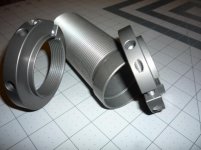
Elephant Racing sleeve and adjusters for 50mm Koni. RT Shock is about 47mm.
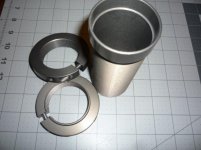
Elephant racing sleeve and adjusters for 50mm Koni. Note enlargement on the end. That has to go.
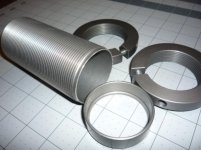
Enlargement removed.
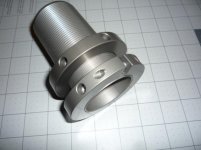
Sleeve assembled. Use one adjuster glued and clamped in place as a foot for the spring perch. I put the cut end of the sleeve down.
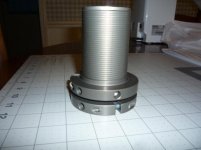
Sleeve ready to install.
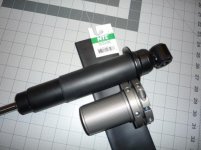
2 layers of 2” thin wall heat shrink will make up the slack between the 47mm shock and the 50mm sleeve.
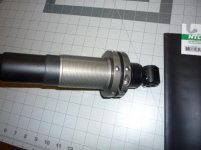
Sleeve on shock with heat shrink.
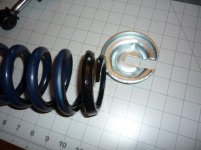
You have to dress the end of the 2.25 I.D. spring down to fit the top retainer.
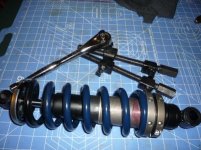
Finished product, ready to install. With the 9” long spring it had about .200” preload. Had to use spring compressors to install. 8” long spring won’t have this problem.
First establish baseline. What is the OEM topping measurement, the free sag (unladen) and the sag (laden)? I’m pretty sure Can Am had their rear suspension designed well enough, so I decided to just work off their measurements.
OEM Setup with ±43 PSI in the air bag and OEM spring (appropriate for my weight plus my normal cargo) measurements to the floor. Topped 17.5”, Free Sag (unladen) 16.5”, Sag 15” (this is my normal ride height as maintained by the compressor). I know these numbers don’t come close to real suspension measurements; they were taken off the tip of the rear fender to the floor. Air compressor came on at 13”, bleed valve opened at 17”. The 15” rear ride height is right in the center of the span of the air leveling system. If you deviate from the OEM ride height set for your bike it will throw a C210A “Suspension Fault” code at you. Note these numbers are specific to my Spyder ( I have non OEM car tires), yours may be different.
Installed a 600 Lb/In Hyperco 9” free length spring on my sleeve setup. I used 9” only because it was real cheap on Ebay. Strongly suggest 8” as you won’t need spring compressors (you will need spring compressors to remove OEM spring). Started with 1” preload, that was too much. Reduced it to .75”, ride height was still a tad high. Ended up with about .625”. Bike rides like OEM air system is active, but can use zero air pressure (for my load and body weight). Preload adjusters are so far up in the bike, and room is so tight, you will need some kind of narrow, long reach preload adjuster to get to the adjusters. I made one that worked.
As proof of design, I rode single, using the preload to adjust the rear height level so that 5-7 PSI remaining in the air bag to keep it from pinching. Lower preload will add more air to the bag as the automatic leveling system seeks a height, higher will reduce the air bag pressure until the bike goes too high, resulting in the suspension fault code C210A. I then rode with about 170 Lbs on the pillion, and the airbag pumped up and stabilized at 35 PSI with that load. Upon riding with just me on board, the airbag returned to 5-7 PSI, and the air compressor and bleed valve never comes on.
Parts List:
1- 188A0600 Hyperco 600 Lb/In spring 8” long x 2.25” I.D. $70 on Ebay
2- 2280913A Coilover sleeve for 2.25 inch springs, 50mm shock body, 4.7 inch length, Elephant Racing, 1 needed, $40
3- 2280913B Coilover sleeve lower adjuster for 2.25 inch springs and 2280913A sleeve, Elephant Racing, 2 needed, $30 (each, $60 total)
4- Upgrade bolt from Fastenal, M10 x 140 10.9 or 12.9 grade for lower mount, 1 needed (Each $15).
Additional Disclaimer- This is a work in progress. I do not claim to be an expert at anything, and may change spring rates to suit me. Currently the setup rides smoothly and maintains a cushy ride which matches my level of spine damage. If it ever bottoms out I will go up in spring rate to test for comfort mainly, as sport riding is secondary to me. This post is for informational purposes only, do not put any of this into practice.

Elephant Racing sleeve and adjusters for 50mm Koni. RT Shock is about 47mm.

Elephant racing sleeve and adjusters for 50mm Koni. Note enlargement on the end. That has to go.

Enlargement removed.

Sleeve assembled. Use one adjuster glued and clamped in place as a foot for the spring perch. I put the cut end of the sleeve down.

Sleeve ready to install.

2 layers of 2” thin wall heat shrink will make up the slack between the 47mm shock and the 50mm sleeve.

Sleeve on shock with heat shrink.

You have to dress the end of the 2.25 I.D. spring down to fit the top retainer.

Finished product, ready to install. With the 9” long spring it had about .200” preload. Had to use spring compressors to install. 8” long spring won’t have this problem.
